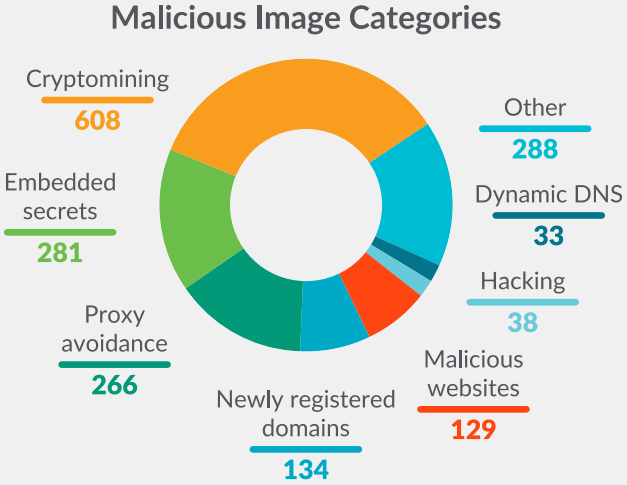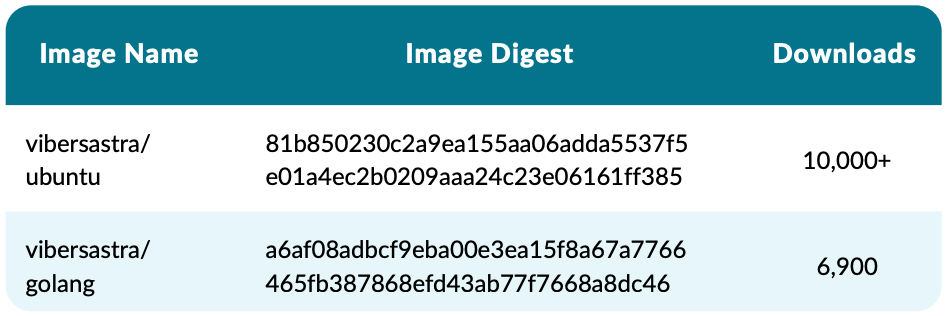Over 1,600 publicly available Docker Hub images hide malicious behavior, including cryptocurrency miners, embedded secrets that can be used as backdoors, DNS hijackers, and website redirectors.
Docker Hub is a cloud-based container library allowing people to freely search and download Docker images or upload their creations to the public library or personal repositories.
Docker images are templates for the quick and easy creation of containers that contain ready-to-use code and applications. Therefore, those looking to set up new instances often turn to Docker Hub to quickly find an easily deployable application.
Unfortunately, due to abuse of the service by threat actors, over a thousand malicious uploads introduce severe risks to unsuspecting users deploying malware-laden images on locally hosted or cloud-based containers.
Many malicious images use names that disguise them as popular and trustworthy projects, so threat actors clearly uploaded them to trick users into downloading them.
Researchers at Sysdig looked into the issue, trying to evaluate the scale of the problem, and reported on the found images that feature some form of malicious code or mechanism.
Docker Hub traps
Apart from images reviewed by the Docker Library Project, which are verified to be trustworthy, hundreds of thousands of images with an unknown status are on the service.
Sysdig used its automated scanners to scrutinize 250,000 unverified Linux images and identified 1,652 of them as malicious.

Types of malicious images on Docker Hub (Sysdig)
The largest category was that of crypto-miners, found in 608 container images, targeting server resources to mine cryptocurrency for the threat actors.
The second most-common occurrence were images hiding embedded secrets, measuring 281 cases. The secrets embedded in these images are SSH keys, AWS credentials, GitHub tokens, NPM tokens, and others.

Types of secrets left in Docker images (Sysdig)
Sysdig comments that these secrets may have been left on public images by mistake or intentionally injected by the threat actor who created and uploaded them.
“By embedding an SSH key or an API key into the container, the attacker can gain access once the container is deployed,” warns Sysdig in the report.
“For instance, uploading a public key to a remote server allows the owners of the corresponding private key to open a shell and run commands via SSH, similar to implanting a backdoor.”
Many malicious images discovered by Sysdig used typosquatting to impersonate legitimate and trusted images, only to infect users with crypto-miners.
This tactic lays the ground for some highly successful cases, like the two examples shown below, that have been downloaded almost 17,000 times.

Docker images containing coinminers (Sysdig)
Typosquatting also ensures that users mistyping the name of a popular project will download a malicious image, so while this doesn’t produce large victim counts, it still ensures a steady stream of infections.
.png)
Typosquatted images capturing random mistypes (Sysdig)
A worsening problem
Sysdig says that in 2022, 61% of all images pulled from Docker Hub come from public repositories, a 15% rise from 2021 stats, so the risk for users is on the rise.
Unfortunately, the size of the Docker Hub public library does not allow its operators to scrutinize all uploads daily; hence many malicious images go unreported.
Sysdig also noticed that most threat actors only upload a couple of malicious images, so even if a risky image is removed and the uploader is banned, it doesn’t significantly impact the platform’s threat landscape.




Recommended Comments
There are no comments to display.
Join the conversation
You can post now and register later. If you have an account, sign in now to post with your account.
Note: Your post will require moderator approval before it will be visible.